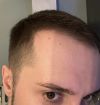community Not sure what else to do, can’t use anti-androgens (Baseline Hormonal Bloodwork included) need advice badly
User experienced feminizing side effects from finasteride and tried RU, alfatradiol, and finasteride without success. They are now considering treatments like Stemoxydine, Zix, Minoxidil, Dermarolling, Eucapil, and a hair transplant.
